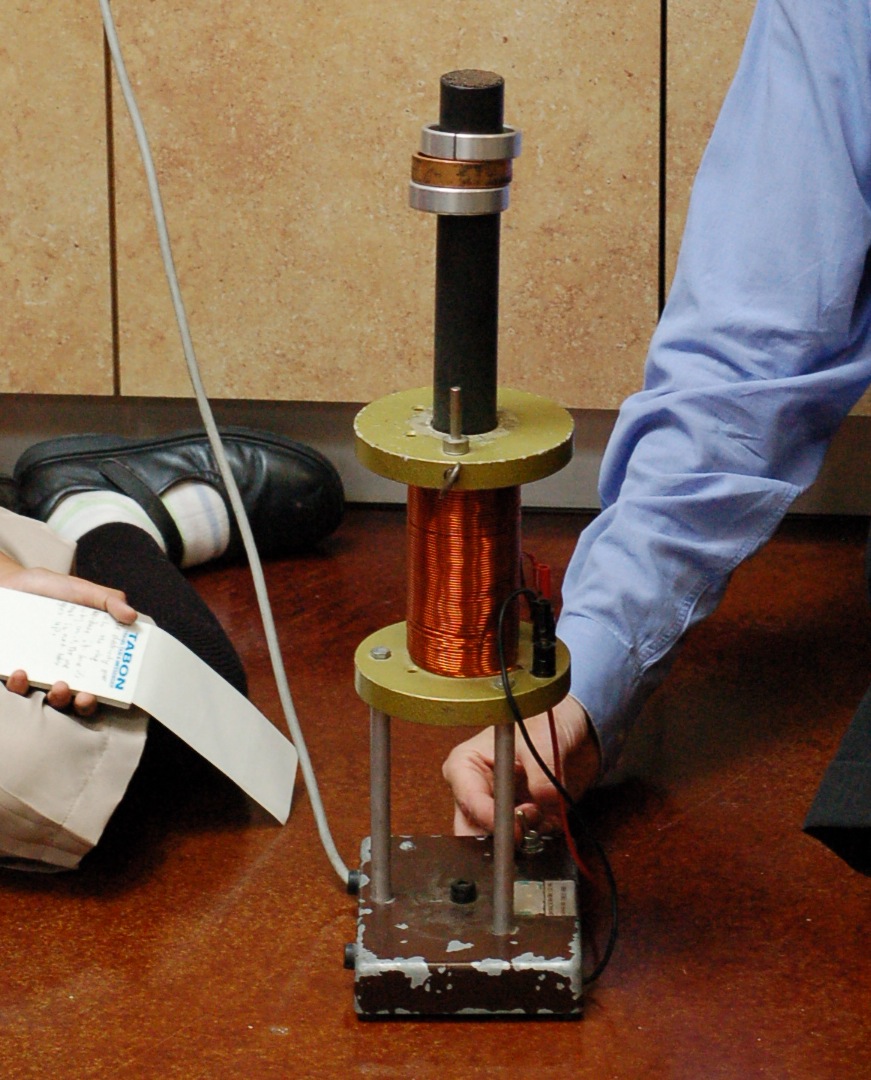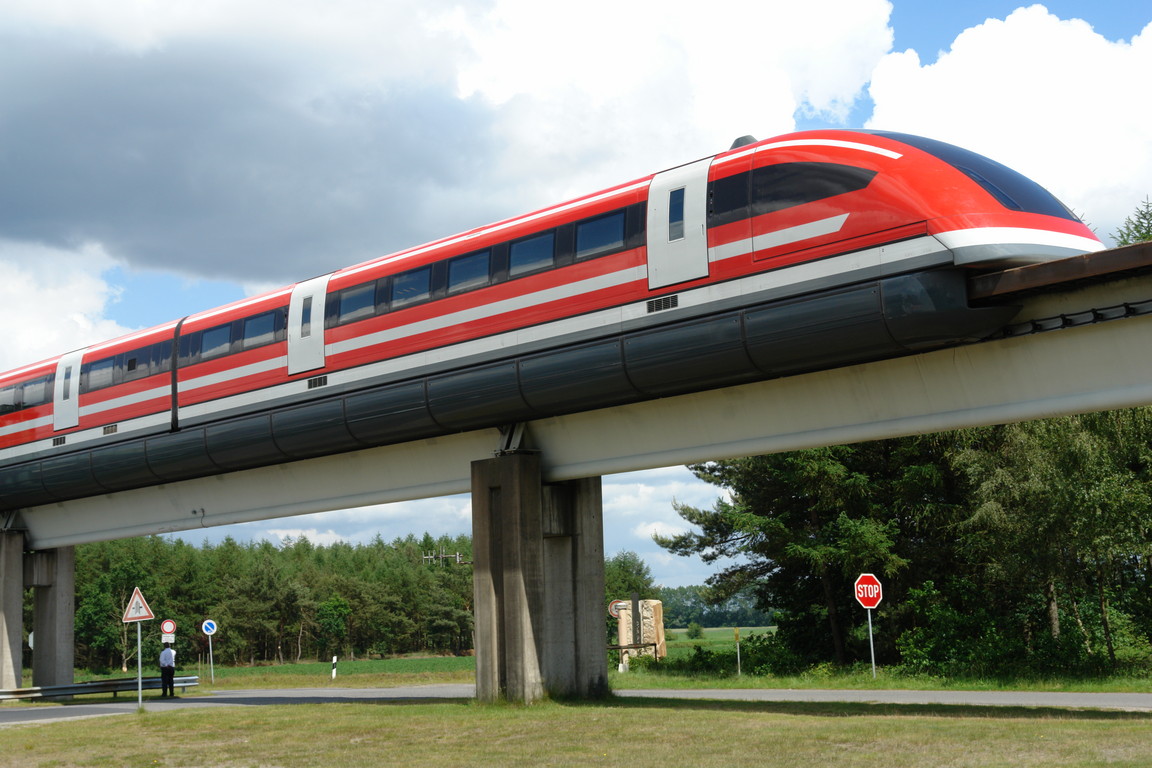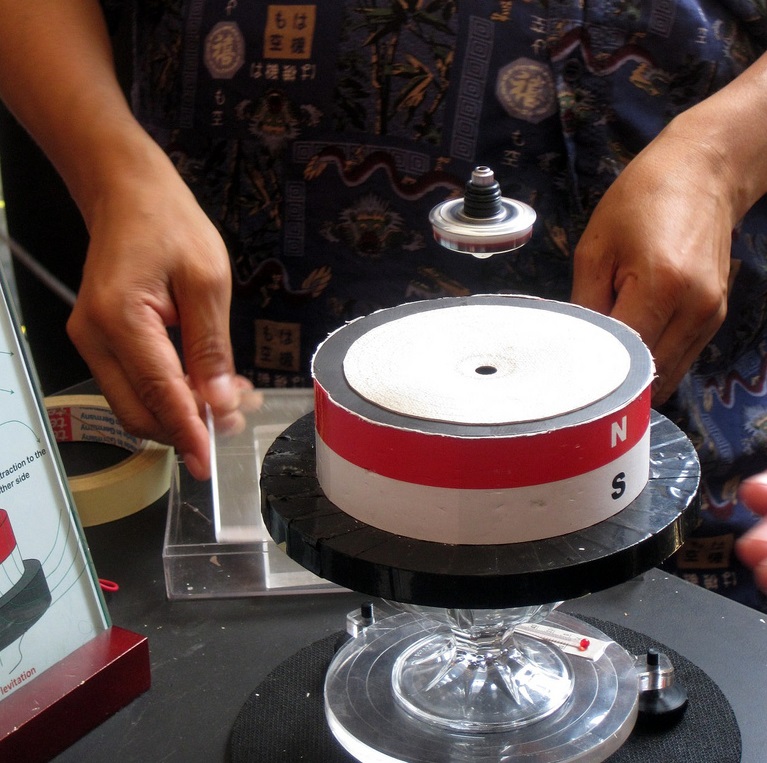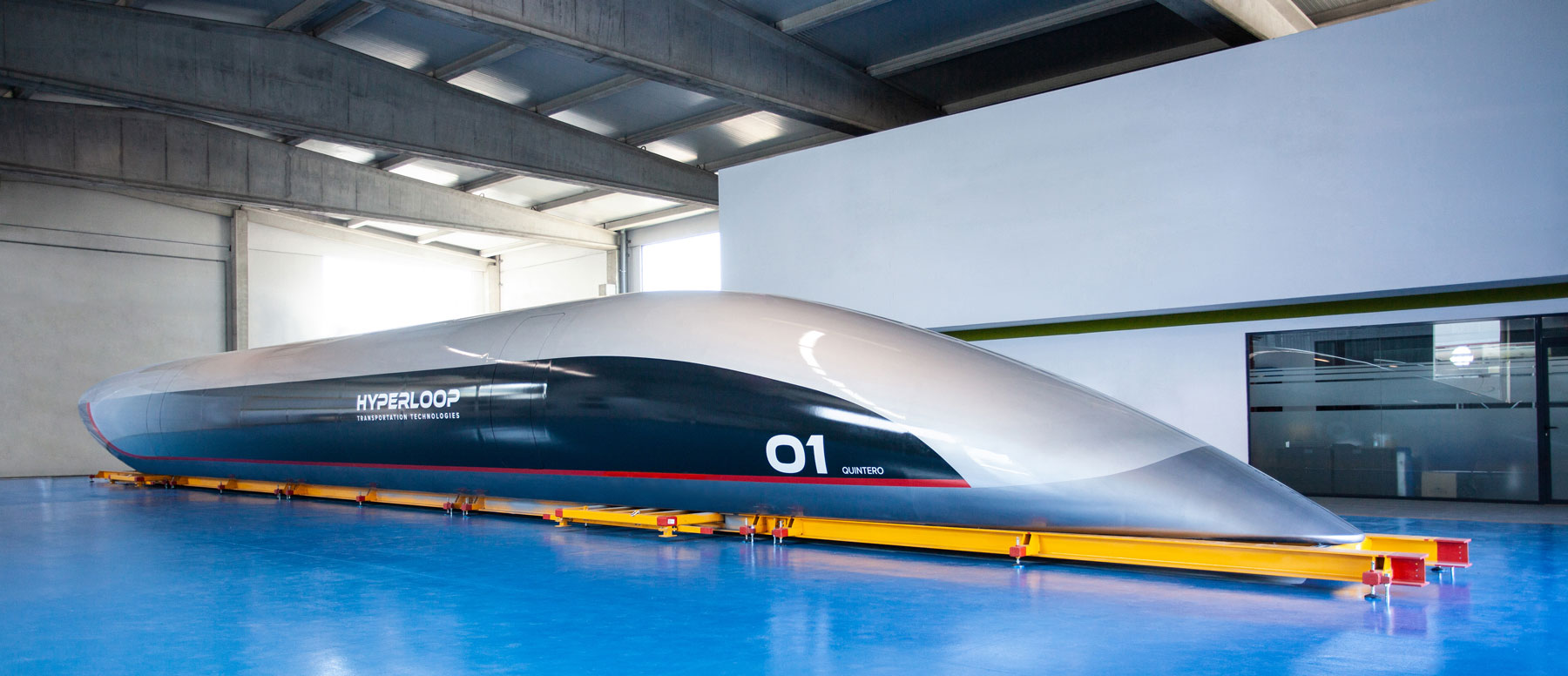|
Inductrack
Inductrack is a passive, fail-safe electrodynamic magnetic levitation system, using only unpowered loops of wire in the track and perslide magnets (arranged into Halbach arrays) on the vehicle to achieve magnetic levitation. The track can be in one of two configurations, a "ladder track" and a "laminated track". The ladder track is made of unpowered Litz wire cables, and the laminated track is made out of stacked copper or aluminium sheets. There are three designs: Inductrack I, which is optimized for high speed operation, Inductrack II, which is more efficient at lower speeds, and Inductrack III, which is intended for heavy loads at low speed. Inductrack (or Inductrak) was invented by a team of scientists at Lawrence Livermore National Laboratory in California, headed by physicist Richard F. Post, for use in maglev trains, based on technology used to levitate flywheels. At constant velocity, power is required only to push the train forward against air and electromagnetic drag. ... [...More Info...] [...Related Items...] OR: [Wikipedia] [Google] [Baidu] |
Halbach Array
A Halbach array is a special arrangement of permanent magnets that augments the magnetic field on one side of the array while cancelling the field to near zero on the other side. This is achieved by having a spatially rotating pattern of magnetisation. The rotating pattern of permanent magnets (on the front face; on the left, up, right, down) can be continued indefinitely and have the same effect. The effect of this arrangement is roughly similar to many horseshoe magnets placed adjacent to each other, with similar poles touching. The principle was first invented by James (Jim) M. Winey of Magnepan in 1970, for the ideal case of continuously rotating magnetization, induced by a one-sided stripe-shaped coil. The effect was also discovered by John C. Mallinson in 1973, and these "one-sided flux" structures were initially described by him as a "curiosity", although at the time he recognized from this discovery the potential for significant improvements in magnetic tape techno ... [...More Info...] [...Related Items...] OR: [Wikipedia] [Google] [Baidu] |
Electrodynamic Suspension
Electrodynamic suspension (EDS) is a form of magnetic levitation in which there are conductors which are exposed to time-varying magnetic fields. This induces eddy currents in the conductors that creates a repulsive magnetic field which holds the two objects apart. These time varying magnetic fields can be caused by relative motion between two objects. In many cases, one magnetic field is a permanent field, such as a permanent magnet or a superconducting magnet, and the other magnetic field is induced from the changes of the field that occur as the magnet moves relative to a conductor in the other object. Electrodynamic suspension can also occur when an electromagnet driven by an AC electrical source produces the changing magnetic field, in some cases, a linear induction motor generates the field. EDS is used for maglev trains, such as the Japanese SCMaglev. It is also used for some classes of magnetically levitated bearings. Types Many examples of this have been used over the y ... [...More Info...] [...Related Items...] OR: [Wikipedia] [Google] [Baidu] |
Maglev
Maglev (derived from '' magnetic levitation''), is a system of train transportation that uses two sets of electromagnets: one set to repel and push the train up off the track, and another set to move the elevated train ahead, taking advantage of the lack of friction. Such trains rise approximately off the track. There are both high speed, intercity maglev systems (over ), and low speed, urban maglev systems ( to ) being built and under construction and development. With maglev technology, the train travels along a guideway of electromagnets which control the train's stability and speed. While the propulsion and levitation require no moving parts, the bogies can move in relation to the main body of the vehicle and some technologies require support by retractable wheels at low speeds under . This compares with electric multiple units that may have several dozen parts per bogie. Maglev trains can therefore in some cases be quieter and smoother than conventional trains and have t ... [...More Info...] [...Related Items...] OR: [Wikipedia] [Google] [Baidu] |
Maglev
Maglev (derived from '' magnetic levitation''), is a system of train transportation that uses two sets of electromagnets: one set to repel and push the train up off the track, and another set to move the elevated train ahead, taking advantage of the lack of friction. Such trains rise approximately off the track. There are both high speed, intercity maglev systems (over ), and low speed, urban maglev systems ( to ) being built and under construction and development. With maglev technology, the train travels along a guideway of electromagnets which control the train's stability and speed. While the propulsion and levitation require no moving parts, the bogies can move in relation to the main body of the vehicle and some technologies require support by retractable wheels at low speeds under . This compares with electric multiple units that may have several dozen parts per bogie. Maglev trains can therefore in some cases be quieter and smoother than conventional trains and have t ... [...More Info...] [...Related Items...] OR: [Wikipedia] [Google] [Baidu] |
Magnetic Levitation
Magnetic levitation (maglev) or magnetic suspension is a method by which an object is suspended with no support other than magnetic fields. Magnetic force is used to counteract the effects of the gravitational force and any other forces. The two primary issues involved in magnetic levitation are ''lifting forces'': providing an upward force sufficient to counteract gravity, and ''stability'': ensuring that the system does not spontaneously slide or flip into a configuration where the lift is neutralized. Magnetic levitation is used for maglev trains, contactless melting, magnetic bearings and for product display purposes. Lift Magnetic materials and systems are able to attract or repel each other with a force dependent on the magnetic field and the area of the magnets. For example, the simplest example of lift would be a simple dipole magnet positioned in the magnetic fields of another dipole magnet, oriented with like poles facing each other, so that the force between mag ... [...More Info...] [...Related Items...] OR: [Wikipedia] [Google] [Baidu] |
Lift To Drag Ratio
In aerodynamics, the lift-to-drag ratio (or L/D ratio) is the lift generated by an aerodynamic body such as an aerofoil or aircraft, divided by the aerodynamic drag caused by moving through air. It describes the aerodynamic efficiency under given flight conditions. The L/D ratio for any given body will vary according to these flight conditions. For an aerofoil wing or powered aircraft, the L/D is specified when in straight and level flight. For a glider it determines the glide ratio, of distance travelled against loss of height. The term is calculated for any particular airspeed by measuring the lift generated, then dividing by the drag at that speed. These vary with speed, so the results are typically plotted on a 2-dimensional graph. In almost all cases the graph forms a U-shape, due to the two main components of drag. The L/D may be calculated using computational fluid dynamics or computer simulation. It is measured empirically by testing in a wind tunnel or in free flight te ... [...More Info...] [...Related Items...] OR: [Wikipedia] [Google] [Baidu] |
Hyperloop Transportation Technologies
Hyperloop Transportation Technologies, also known as HyperloopTT, is an American research company formed using a crowd collaboration approach (a mix of team collaboration and crowdsourcing) Lynda Applegate, Terri L. Griffith, and Ann Majchrzak''Hyperloop Transportation Technologies: Building Breakthrough Innovations in Crowd-Powered Ecosystems''.Harvard Business School Case 817-134, May 2017. (Revised October 2017.) to develop around the world commercial transportation systems based on the Hyperloop concept. The concept of the Hyperloop was popularized in 2013 by Elon Musk, not affiliated with HyperloopTT. The project was to develop a high speed, intercity transporter using a low pressure tube train which would reach a top speed of with a yearly capacity of 15 million passengers. HyperloopTT also plans to build slower, urban Hyperloops for inter-suburb travel. History JumpStarter, Inc The company was founded by JumpStarter, Inc., utilizing the company's crowdfunding ... [...More Info...] [...Related Items...] OR: [Wikipedia] [Google] [Baidu] |
Personal Rapid Transit
Personal rapid transit (PRT), also referred to as podcars or guided/railed taxis, is a public transport mode featuring small low-capacity automated vehicles operating on a network of specially built guideways. PRT is a type of automated guideway transit (AGT), a class of system which also includes larger vehicles all the way to small subway systems. In terms of routing, it tends towards personal public transport systems. PRT vehicles are sized for individual or small group travel, typically carrying no more than three to six passengers per vehicle. Guideways are arranged in a network topology, with all stations located on sidings, and with frequent merge/diverge points. This allows for nonstop, point-to-point travel, bypassing all intermediate stations. The point-to-point service has been compared to a taxi or a horizontal lift (elevator). Numerous PRT systems have been proposed but most have not been implemented. , only a handful of PRT systems are operational: Morgantown Per ... [...More Info...] [...Related Items...] OR: [Wikipedia] [Google] [Baidu] |
Popular Mechanics
''Popular Mechanics'' (sometimes PM or PopMech) is a magazine of popular science and technology, featuring automotive, home, outdoor, electronics, science, do-it-yourself, and technology topics. Military topics, aviation and transportation of all types, space, tools and gadgets are commonly featured. It was founded in 1902 by Henry Haven Windsor, who was the editor and—as owner of the Popular Mechanics Company—the publisher. For decades, the tagline of the monthly magazine was "Written so you can understand it." In 1958, PM was purchased by the Hearst Corporation, now Hearst Communications. In 2013, the US edition changed from twelve to ten issues per year, and in 2014 the tagline was changed to "How your world works." The magazine added a podcast in recent years, including regular features ''Most Useful Podcast Ever'' and ''How Your World Works''. History ''Popular Mechanics'' was founded in Chicago by Henry Haven Windsor, with the first issue dated January 11, 1902. ... [...More Info...] [...Related Items...] OR: [Wikipedia] [Google] [Baidu] |
Hyperloop
A hyperloop is a proposed high-speed transportion system for both public and goods transport. The idea was picked up by Elon Musk to describe a modern project based on the vactrain concept (first appearance in 1799). Hyperloop systems comprise three essential elements: tubes, pods, and terminals. The tube is a large, sealed and low-pressure system (usually a long tunnel). The pod is a coach pressurized at atmospheric pressure that runs substantially free of air resistance or friction inside this tube using magnetic propulsion (in some cases augmented by a ducted fan). The terminal handles pod arrivals and departures. The Hyperloop, in the initial form proposed by Musk, differs from vactrains by relying on residual air pressure inside the tube to provide lift by aerofoils and propulsion by fans. The hyperloop has its roots in a concept by George Medhurst in 1799 and subsequently developed under the names pneumatic railway, atmospheric railway or vactrain. Elon Musk renewed in ... [...More Info...] [...Related Items...] OR: [Wikipedia] [Google] [Baidu] |
General Atomics
General Atomics is an American energy and defense corporation headquartered in San Diego, California, specializing in research and technology development. This includes physics research in support of nuclear fission and nuclear fusion energy. The company also provides research and manufacturing services for remotely operated surveillance aircraft, including the General Atomics MQ-1 Predator, Predator drones, airborne sensors, and advanced electric, electronic, wireless, and laser technologies. History General Atomics (GA) was founded on July 18, 1955, in San Diego San Diego ( , ; ) is a city on the Pacific Ocean coast of Southern California located immediately adjacent to the Mexico–United States border. With a 2020 population of 1,386,932, it is the List of United States cities by population, eigh ..., California, by Frederic de Hoffmann with assistance from notable physicists Edward Teller and Freeman Dyson. Originally the company was part of the General Atomic divi ... [...More Info...] [...Related Items...] OR: [Wikipedia] [Google] [Baidu] |
NASA
The National Aeronautics and Space Administration (NASA ) is an independent agency of the US federal government responsible for the civil space program, aeronautics research, and space research. NASA was established in 1958, succeeding the National Advisory Committee for Aeronautics (NACA), to give the U.S. space development effort a distinctly civilian orientation, emphasizing peaceful applications in space science. NASA has since led most American space exploration, including Project Mercury, Project Gemini, the 1968-1972 Apollo Moon landing missions, the Skylab space station, and the Space Shuttle. NASA supports the International Space Station and oversees the development of the Orion spacecraft and the Space Launch System for the crewed lunar Artemis program, Commercial Crew spacecraft, and the planned Lunar Gateway space station. The agency is also responsible for the Launch Services Program, which provides oversight of launch operations and countdown management f ... [...More Info...] [...Related Items...] OR: [Wikipedia] [Google] [Baidu] |







